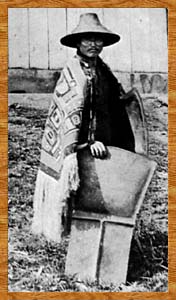
 Clothing Clothing
 Headresses Headresses
 Raven Rattles Raven Rattles
 Copper Shields Copper Shields |
Clothing
In precontact times, most items of Haida clothing were woven from red or yellow cedar bark. After the bark was peeled in long strips from the trees, the outer layer was split away, and the flexible inner layer was shredded and processed. The resulting felted strips of bark were soft and could be plaited, sewn or woven into a variety of fabrics that were either dense and watertight, or soft and comfortable. Women wore skirts and capes of cedar bark, while men wore long capes of cedar bark into which some mountain goat wool was woven for decorative effect. These items of clothing are well depicted in drawings by Sigismond Bacstrom, an artist aboard a trading ship, the Three Brothers, which visited Haida Gwaii in 1793.

 |
This photograph shows a Haida chief of the previous century in traditional dress, displaying his wealth of coppers before his lineage house (Haina village).
Photograph by Richard Maynard, 1888 |

Early examples of chief's capes have repetitive patterns of trophy heads, but after warfare was suppressed by the traders, the trophy heads were replaced with crest figures, and the amount of wool used was increased to the point where the cedar bark warps could not even be seen. The fur of sea otter or other animals was added to the neckline of capes for those of chiefly rank.
After contact, the everyday wear of men and women was an unadorned trade blanket, worn as a wraparound garment during the day and used as a covering at night. Slaves were clothed in handed-down blankets.
|